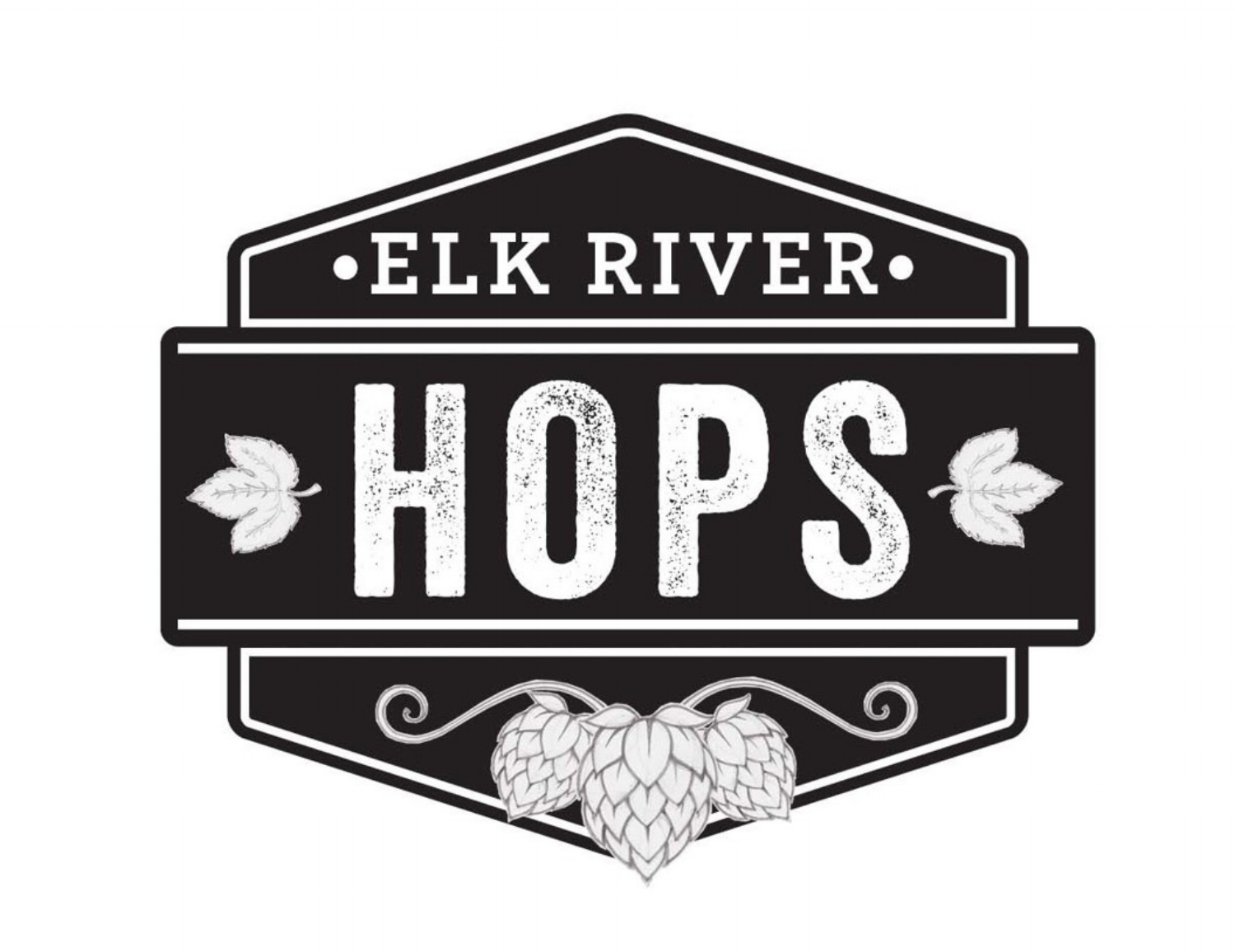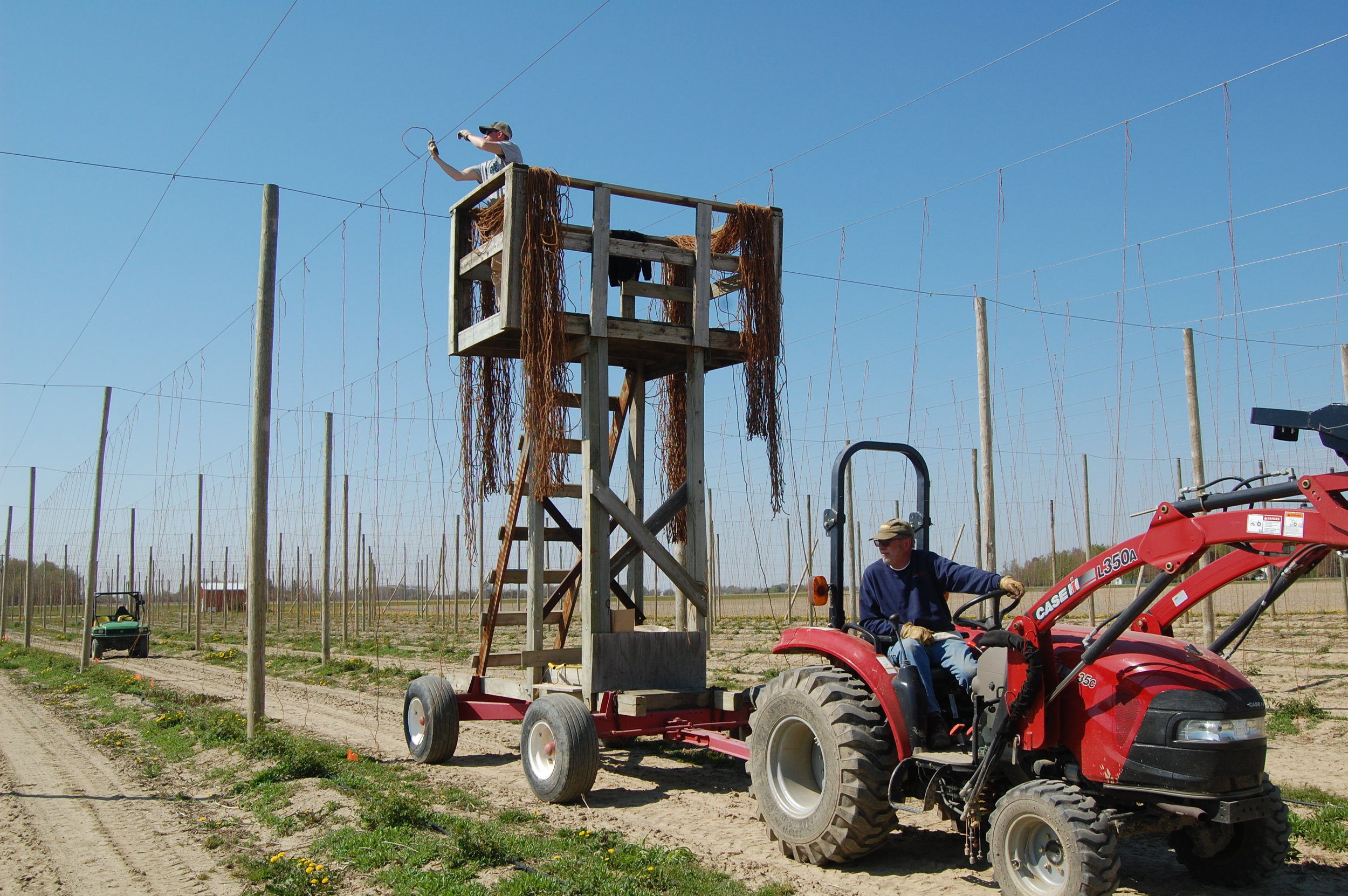Join Us in the Yard!
Throughout the year, we are always working to improve the quality of our hops.
Stringing
The first major task in the spring is hanging the strings that the hop plants will utilize as they grow. A grid of cables is suspended on poles between 18 and 20 feet above the ground. A special twine made from coconut fiber call coir is tied to the cables on top and then anchored in the ground using W-clips. Two strings are placed next to each hop crown. We drop between 20,000 and 25,000 strings per year to cover our 12 acres of hops.
Training
Once the strings are hung it is time to assist the hop bines in finding the strings so they can commence their spiral dance toward the sun. Many of the bines will find the sun warmed strings on their own because they are attracted to the heat given off by the coir. The bines wrap around the coir in a clockwise manner as they grow. We assist some reluctant bines in finding the coir so that we have between 2 and 4 bines on each length of string depending on the variety. Not all bines are trained to a string. Some of the earlier bines are actually discarded because they have hollow stems and tend to break off during the year. These "Bull" hops tend to grow faster but have less hop cones on them at harvest. We try to remove plant material that is not actively growing up a string to improve airflow at the base of the plant and to reduce the potential of mildew which can harm the plants.
Integrated Pest Management
There are a lot of pests that can harm a hop bine as it grows and matures. The first line of defense is to produce a healthy plant by providing appropriate levels of fertilizer and water. We hill up our plant rows with a small ditch on each side of the hill so that the plants are not standing in water. The heavy clay soil on our farm retains a lot of water which the hop plants can access through their deep root system. We fertilize every 4-5 days with direct application of specialized liquid fertilizers that have been specifically developed for hops. Downey and powdery mildew are two of the biggest problems with hops. We utilize a tower based orchard sprayer to apply a number of different fungicides to the hop plants on a weekly basis. The type of fungicide is changed each week to reduce the chance of resistance developing in the fungus. Insects are another challenge to the hop grower. There is a wide variety of insects that can infest the hopyard but the most common are aphids, spider mites and Japanese beetles. Weather conditions have a direct impact on the pests that need to be addressed every week. The best way to decide on what needs to be done is to walk the hopyard and examine the plants on a regular basis. A pest control plan can then be developed based on what is seen and what can be expected based on growing conditions.
Harvesting
Harvest is always an exciting time. After spending all summer nurturing the hop plant it is now time to cut in down and tear it apart! The first activity is to determine when the cones are ready for harvest. Appropriate harvest timing is based on the percent dry matter of the plant, the amount of alpha acid present in to cone or by a combination of sensory inputs such as color, aroma and feel of the cone developed after years of growing hops. We use the alpha acid content and moisture to determine when the variety is ready for harvest.
The harvest begins with cutting down the bine and the string and transporting the bines to the harvest equipment. The bines are pulled through the harvester which first strips the cones and leaves from the stalk and string. The harvester then separates the leaves from the cones using gravity and airflow. Once to cones are separated from the rest of the plant, they have to be dried down to about 12% moisture in dryers that use warm air and air flow to gently dry the hops. Once the hop cone is dried it is placed in a conditioning space so that the internal structure of the hop can come to a uniform dryness. The last step of the harvest process is that the dried hops are baled in bags, label as to contents and origin and then stored in a refrigerated space.
Processing
Processing usually begins after the completion of the harvest. Hops are sold in many forms including fresh hops, whole hops, ground hops, pelletized hops and hop oils. The most common is pelletized hops. The hop bale is opened and the cones are ground to a powder in a hammer mill. The ground hops are then fed into a pellet mill where they are pressed into pellets using pressure and mild heat. It is important to keep the heat of the pellets below 120 degrees Fahrenheit to protect the essential oils from destruction. Once the pellets have cooled, they are packaged in food grade Mylar bags to protected them from light. Nitrogen gas is forced into the bag before sealing to displace any air that is present in the bag. Protection from light and air improves the storage characteristics of the finished hop.





